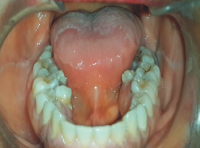Nonsyndromic Multiple Erupted Supernumerary Teeth in a 46-Year Old Female: A Case Report
Main Article Content
Abstract
Background: Supernumerary is one of the common dental anomalies and it denotes more than the full complement of teeth in the dental arch. Most times it occurs in association with developmental anomalies and syndromes. Sometimes, it occurs without any developmental anomaly or syndrome. Nonsyndromic supernumeraries are rare and the reported prevalence among Nigerians is less than 1%. It is more commonly reported in males and younger age groups. In 75% of cases they fail to erupt into the mouth, where they
erupt, they are commonly seen on the mandibular premolar region. Supernumerary teeth constitute a health hazard and presents a clinical situation that is challenging to diagnose and treat. It causes crowding,
predisposes to caries and periodontal diseases and interfere with mastication, speech and esthetics.
Case report: This paper reports a rarer case of non-syndromic bilateral mandibular supernumerary teeth in a systemically healthy 46-year old woman.
Downloads
Article Details
Section

This work is licensed under a Creative Commons Attribution-NonCommercial-NoDerivatives 4.0 International License.
The Journal is owned, published and copyrighted by the Nigerian Medical Association, River state Branch. The copyright of papers published are vested in the journal and the publisher. In line with our open access policy and the Creative Commons Attribution License policy authors are allowed to share their work with an acknowledgement of the work's authorship and initial publication in this journal.
This is an open access journal which means that all content is freely available without charge to the user or his/her institution. Users are allowed to read, download, copy, distribute, print, search, or link to the full texts of the articles in this journal without asking prior permission from the publisher or the author.
The use of general descriptive names, trade names, trademarks, and so forth in this publication, even if not specifically identified, does not imply that these names are not protected by the relevant laws and regulations. While the advice and information in this journal are believed to be true and accurate on the date of its going to press, neither the authors, the editors, nor the publisher can accept any legal responsibility for any errors or omissions that may be made. The publisher makes no warranty, express or implied, with respect to the material contained herein.
TNHJ also supports open access archiving of articles published in the journal after three months of publication. Authors are permitted and encouraged to post their work online (e.g, in institutional repositories or on their website) within the stated period, as it can lead to productive exchanges, as well as earlier and greater citation of published work (See The Effect of Open Access). All requests for permission for open access archiving outside this period should be sent to the editor via email to editor@tnhjph.com.
How to Cite
References
Yusof WZ. Non-syndrome multiple supernumerary teeth. Literature review. J Can Dent Assoc 1990;56(2):147–9.
Garvey MT, Barry HJ, Blake M. Supernumerary teeth--an overview of classification, diagnosis and management. J Can Dent Assoc 1999;65(11):612–6.
Mali S, Karjodkar FR, Sontakke S, Sansare K. Supernumerary teeth in non-syndromic patients. Imaging Sci Dent 2012;42(1):41–5.
Yagüe-García J, Berini-Aytés L, Gay-Escoda C. Multiple supernumerary teeth not associated with complex syndromes: A retrospective study. Med Oral Patol Oral Cir Bucal 2009;14(7):E331–6.
Shah AK, Joshi MU. Nonsyndromic multiple supernumerary premolars: Report of three cases. Health Agenda 2013;1(3):85‑9.
Anegundi RT, Tegginmani VS, Battepati P, Tavargeri A, Patil S, Trasad V, et al. Prevalence and characteristics of supernumerary teeth in a non‑syndromic South Indian pediatric population. J Indian Soc Pedod Prev Dent 2014;32(1):9‑12.
Açikgöz A, Açikgöz G, Tunga U, Otan F. Characteristics and prevalence of non-syndrome multiple supernumerary teeth: a retrospective study. Dentomaxillofac Radiol 2006;35(3):185–90.
Hattab FN, Yassin OM, Rawashdeh MA. Supernumerary teeth: Report of three cases and review of the literature. ASDC J Dent Child 1994;61(5-6):382-93.
Yassin OM, Hamori E. Characteristics, clinical features and treatment of supernumerary teeth. J Clin Pediatr Dent 2009;33(3):247-50.
Diaz A, Orozco J, Fonseca M. Multiple hyperodontia: Report of a case with 17 supernumerary teeth with non syndromic association. Med Oral Patol Oral Cir Bucal 2009;14(5):E229–31.
Gallas MM, Garcia A. Retention of permanent incisors by mesiodens: A family affair. Br Dent J 2000;188(2):63–4.
Umweni AA, Osunbor GE. Non-syndrome multiple supernumerary teeth in Nigerians. Odontostomatol Trop 2002;25(99):43–8.
Golan I, Baumert U, Hrala BP, Mu¨big D. Early craniofacial signs of cleidocranial dysplasia. Int J Paediatr Dent 2004;14(1):49–53.
Ng’ang’a PM, Guthua SW, Ng’ang’a RN. Multiple supernumerary teeth in association with malocclusion: report of two cases. East Afr Med J 2002;79(4):221–3.
Inchingolo F, Tatullo M, Abenavoli FM, Marrelli M, Inchingolo AD, Gentile M, et al. Non-syndromic multiple supernumerary teeth in a family unit with a normal karyotype: case report. Int J Med Sci 2010;7(6):378–84.

